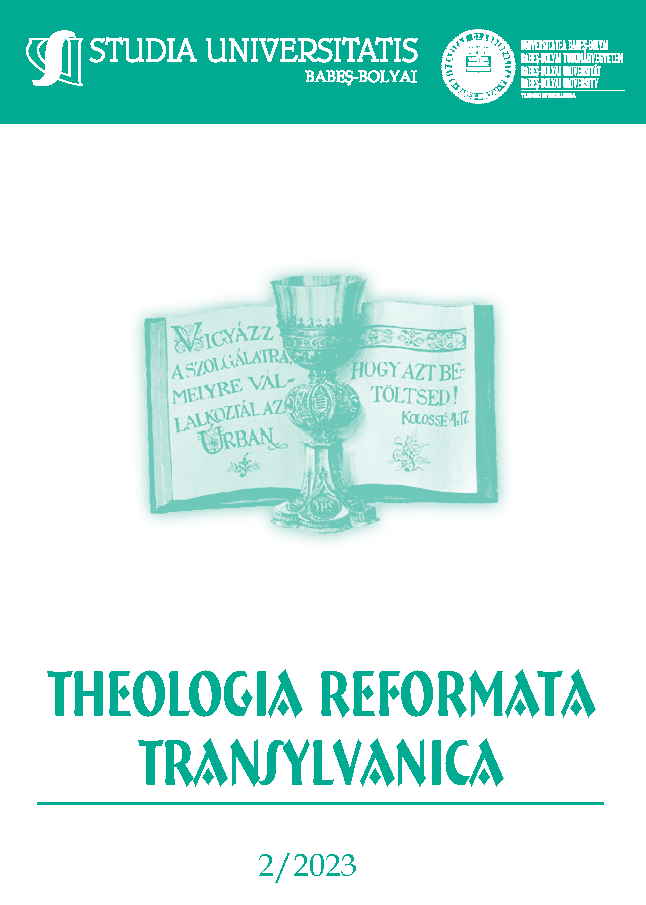Wie hat Paulus die Schrift verwendet – am Beispiel von 1Kor 1,26–31.
DOI:
https://doi.org/10.24193/subbtref.2023.2.04Keywords:
election, interpretation, 1 Corinthians, Pauline theology.Abstract
How did Paul use the Scriptures - using the example of 1 Corinthians 1:26-31?
We have chosen 1Cor for our study because we find no reference to external attacks on the Apostle in this letter. We may therefore assume that Paul used the Old Testament “freely” in his argumentation. Although the apostle was now forced to communicate with the congregation by letter, he nevertheless reminded them of his teaching fifteen times by means of various Old Testament quotations, which obviously referred back to his sermons, or he wished to use them to emphasize the vitality and reality of the dialogue. In our study, we are not looking for an answer to the question of how the first readers of the letter understood these quotations. We do not want to answer the question of how literal the quotations are or on which text they are based. Rather, we want to use a specific text to approach the question of how Paul used these Old Testament references in his argumentation. To do this, we will look at a specific passage, namely 1Cor 1:26–31.
References
BRANICK, Vincent P. (1982): Source and Redaction Analysis of 1 Corinthians 1–3, In: JBL. 101. 2. 251–269.
CIAMPA, Roy E. –ROSNER, Brian S. (2010): The First Letter to the Corinthians. Grand Rapids, Michigan – Cambridge, Eerdmans. (epubformat).
COLLINS, Raymond F. (1999): First Corinthians. Collegeville, Minnesota. The Liturgical Press.
HEIL, John Paul (2005): The Rhetorical Role of Scripture in 1 Corinthians. Atlanta, SBL.
HAYS, Richard B. (1989): Echoes of Scripture in the Letters of Paul. New Haven – London, Yale University Press.
KLAUCK, Hans-Josef (1984): 1. Korintherbrief. Würzburg, Echter Verlag.
KOCH, Dietrich-Alex (1986): Die Schrift als Zeuge des Evangeliums. Tübingen, J.C.B. Mohr.
KOCSEV Miklós (2018): Kontextualitás és igehirdetés, In: Keresztény Magvető. 404–409. (2017): The Importance of the Reformation from Homiletical Aspect, In: Theologiai Szemle. 60. 3. 158–161. (2012): Gyakorlati teológiai szempontok az igehirdetés és igehirdető néhány összefüggésében, In: Hanula Gergely (Hg.): LOGOS TÉS AKOÉS – Az ige megszólalása és megszólaltatása. Tanulmányok a 60 éves Vladár Gábor tiszteletére. Pápa, PRTA. 133–149. (2007): Gyakorlati teológiai témák. Elmélet és praxis, az igehirdetés személyközpontúsága és a szupervízió (Habilitationsarbeit). Balatonszárszó. On: http://regi.reformatus.hu/lap/gyakorlatiteologia/bejegyzes/26/ (2023.08.31.). (2002): Impulzusok a Holland református (Gereformeerd / Hervormd) gyakorlati teológiából az ezredforduló körül (Promotionsarbeit). Debrecen. On: https://dea.lib.unideb.hu/server/api/core/bitstreams/3fedf8ea-8723-4546-98ab-7aab4302aad1/content (2023.08.26.).
KRAUS, Wolfgang – KARRER, Martin (Hg.), Septuaginta Deutsch, Stuttgart, Deutsche Bibelgesellschaft, 2009.
LABAHN, Antje – LABAHN, Michael (2014): Die biblischen Schöpfungsgeschichten als paulinische Argumentationshilfe im Konfliktfall. Zur Rezeption von Genesis 1–3 im 1. Korintherbrief, In Hoffmann, Matthias R. –John, Felix –Popkes, Enno Edzard (Hg.), Paulusperspektieven. Festschrift für Dieter Sänger zum 65. Geburtstag. Neukirchen, Neukirchener Verlag. 82–118.
LINDEMANN, Andreas (2000): Der erste Korintherbrief. Tübingen, J.C.B. Mohr (Paul Siebeck). (1996): Die Schrift als Tradition. Beobachtungen zu den biblischen Zitaten im Ersten Korintherbrief, In: Backhaus, Knut –Untergaßmair, Franz Georg (Hg.): Schrift und Tradition. Festschrift für Josef Ernst zum 70. Geburtstag. Paderborn – München – Wien – Zürich, Ferdinand Schöningh. 199–225.
MALAN, F. S. (1980): The Use of Old Testament in 1 Corinthians, In: ΝΤΣΣΑ. 14. 134–170.
MALCOLM, Matthew R. (2013): Paul and the Rhetoric of Reversal in 1 Corinthians. The Impact of Paul’s Gospel on His Macro-Rhetoric. Cambridge, Cambridge University Press.
O’DAY, Gail R. (1990): Jeremiah 9:22–23 and 1 Corinthians 1:26–31 – A Study in Intertextuality, In: JBL. 109. 2. 259–267.
SCHRAGE, Wolfgang (1991): Der erste Brief an die Korinther (1Kor 1,1–6,11). Zürich u. a., Neukirchener Verlag.
SMIT, Joop F. M. (2003): Epideictic Rhetoric in Paul’s First Letter to the Corinthians 1–4, In: Biblica. 84. 2. 184–201. (2002): „What Is Apollos? What Is Paul?” in Search for the Coherence of First Corinthians 1:10–4:21, In: NT. 44. 3. 231–251.
VEGGE, Tor (2014): Sacred Scripture in the Letters of Paul, In: Hoffmann, Matthias R. – John, Felix – Popkes, Enno Edzard (Hg.): Paulusperspektieven. Festschrift für Dieter Sänger zum 65. Geburtstag. Neukirchen, Neukirchener Verlag. 1–33.
WHITE, Devin L. (2017): Teacher of the Nations. Ancient Educational Traditions and Paul’s Argument in 1Corinthians 1–4. Berlin – Boston, de Gruyter.
WILK, Florian (2023): Der erste Brief an die Korinther. Göttingen, Vandenhoeck & Ruprecht. (1998): Die Bedeutung des Jesajabuches für Paulus. Göttingen, Vandenhoeck & Ruprecht.
WUELLNER, Wilhelm (1973): The Sociological Implication of 1 Corinthians 1:26–28 Reconsidered, In: Livingstone, Elizabeth A. (Hg.): Studia Evangelica VI. Berlin, Akademie Verlag. 666–673. (1970): Haggadic Homily Genre in I Corinthians 1-3, In: JBL. 89. 2. 199–204.
Downloads
Published
How to Cite
Issue
Section
License
Copyright (c) 2023 Studia Universitatis Babeș-Bolyai Theologia Reformata Transylvanica

This work is licensed under a Creative Commons Attribution-NonCommercial-NoDerivatives 4.0 International License.






